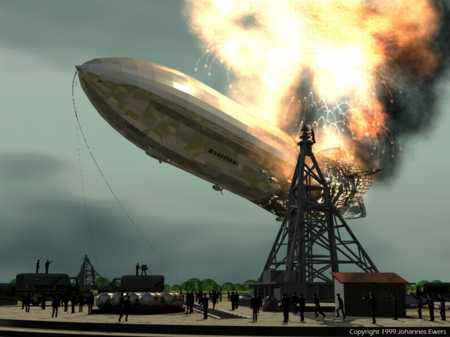Hydrogen: the essentialsBrief description: hydrogen is the lightest element. It is by far the most abundant element in the universe and makes up about about 90% of the universe by weight. Hydrogen as water (H2O) is absolutely essential to life and it is present in all organic compounds. Hydrogen is the lightest gas. Hydrogen gas was used in lighter-than-air balloons for transport but is far too dangerous because of the fire risk (Hindenburg). It burns in air to form only water as waste product and if hydrogen could be made on sufficient scale from other than fossil fuels then there might be a possibility of a hydrogen economy. Note that while normally shown at the top of the Group 1 elements in the periodic table, the term "alkaline metal" refers only to Group 1 elements from lithium onwards.
The lifting agent for the ill fated Hindenberg ballooon was hydrogen rather than the safer helium. The image below is the scene probably in a way you have not seen it before. This is a "ray-traced" image reproduced with the permission of Johannes Ewers, the artist, who won first place with this image in the March/April 1999 Internet Raytracing Competition. For details of ray-tracing you can't beat the POV-Ray site.
IsolationIsolation: in the laboratory, small amounts of hydrogen gas may be made by the reaction of calcium hydride with water. CaH2 + 2H2O → Ca(OH)2 + 2H2 This is quite efficient in the sense that 50% of the hydrogen produced comes from water. Another very convenient laboratory scale experiment follows Boyle's early synthesis, the reaction of iron filings with dilute sulphuric acid. Fe + H2SO4 → FeSO4 + H2 There are many industrial methods for the production of hydrogen and that used will depend upon local factors such as the quantity required and the raw materials to hand. Two processes in use involve heating coke with steam in the water gas shift reaction or hydrocarbons such as methane with steam. CH4 + H2O (1100°C) → CO + 3H2 C(coke) + H2O (1000°C) → CO + H2 In both these cases, further hydrogen may be made by passing the CO and steam over hot (400°C) iron oxide or cobalt oxide. CO + H2O → CO2 + H2 WebElements ShopWebElements now has an online shop at which you can buy periodic table posters, mugs, T-shirts, games, molecular models, and more. |
|||||||||
|
|




 Hydrogen
Hydrogen Hydrogène
Hydrogène Wasserstoff
Wasserstoff Waterstof
Waterstof Idrogeno
Idrogeno Hidrógeno
Hidrógeno Väte
Väte Hidrogênio
Hidrogênio